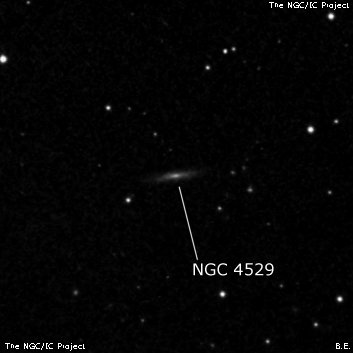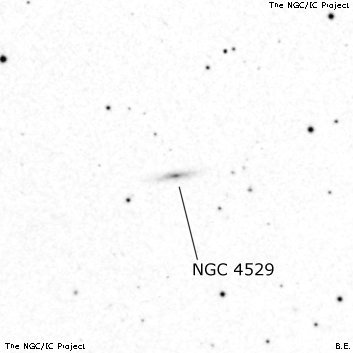NGC/IC Project Restoration Effort
(This is a very very beta version)
NGC4529


Basic Information
Location and Magnitude
Right Ascension: 12:32:51.7
Declination: +20:11:1
Constellation: COM
Visual Magnitude: 14.3
Historic Information
Discoverer: Herschel W.
Year of discovery: 1784
Discovery aperture: 18.7
Observational
Summary description: eF, L
Sub-type: Sc
Corwin's Notes
=====
NGC 4529 may be UGC 7697, but the evidence is not very good. Here are my
comments in response to a question about this object from Steve Gottlieb in
October 1999.
Though WH has two observations, neither of his positions fall near any galaxy
he could have seen. His earlier position (which JH and Dreyer discount in
notes in the GC and NGC; more below) is 1m 20s east and 4.9 arcmin north of
UGC 7697, and 2m 39s east and 12.0 arcmin south of CGCG 129-006. His second
position is 1m 14s east and 20.5 arcmin north of UGC 7697, and 2m 23s east and
2.4 arcmin north of CGCG 129-006.
None of this inspires much confidence in WH's positions, especially given that
Dreyer quotes his first observation in the Papers: "Suspected a L, eF neb,
but tho' I looked at it a good while, I could not verify the suspicion, nor
could I convince myself that it was a deception." Dreyer than adds "P.D.
apparently only approximate," but the offset in the table is not marked with
a colon.
UGC 7697 is somewhat larger and brighter than CGCG 129-006, and has a slightly
higher surface brightness. So, if WH actually saw a galaxy in this area, I
think it is more likely that he saw UGC 7697.
All in all, however, the situation for making a clear identification for
NGC 4529 does not look good, hence the several question marks in the main
table.
Some additional comments: The NGC note is a slightly reworded version of JH's
GC note with the "erratum" in WH's published list merged in. Fortunately,
Dreyer decided to give WH's original data in the main table of his 1912
reprinting of WH's first list. Along with the second observation from 6 years
later in Dreyer's notes, we apparently have all the data WH collected.
Bigourdan's position, which Dreyer sites in support of WH's second
observation, is about 15 arcseconds off a faint star that Bigourdan must have
just barely seen, if, in fact, he saw anything at all.
Wolfgang's position makes his galaxy = MCG +04-30-003 = CGCG 129-006. I do
not know where the PGC's separate entry for NGC 4529 comes from, but the
position is closer to PGC 41463 = CGCG 129-006 than to anything else, so that
probably means that PGC 41482 = PGC 41463.



